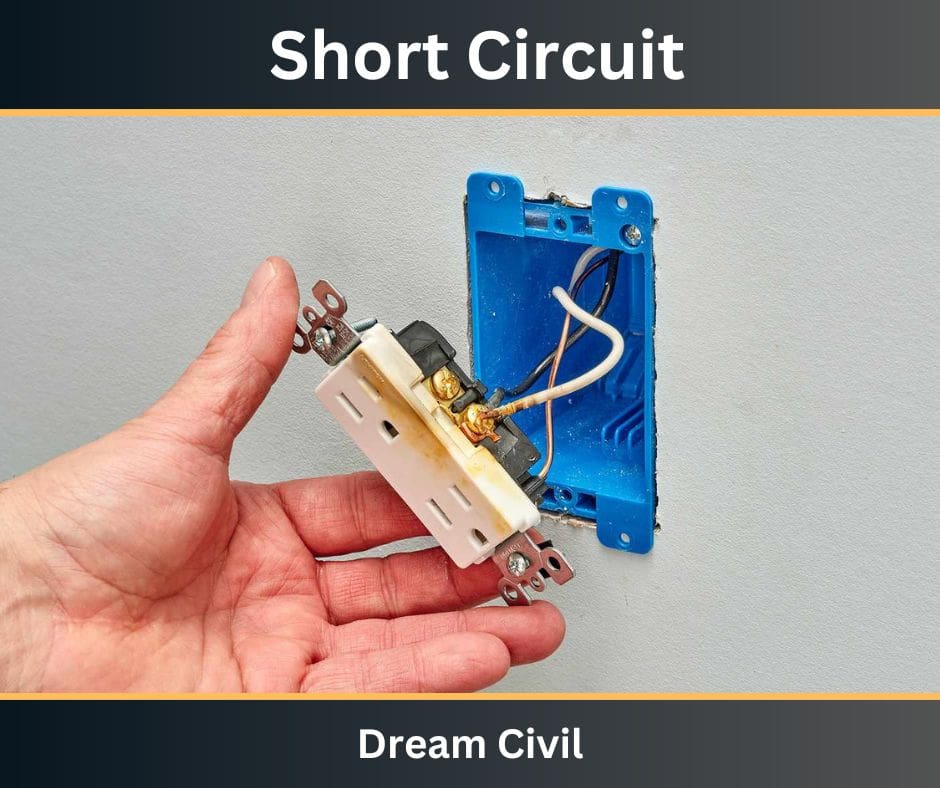Table of Contents
A short circuit mostly takes place when there is a very low-resistance contact between two conductors that provides electricity to a circuit. As an outcome, the power supply would encounter an extreme current flow and surplus voltage streaming. The electricity will move along a “short” path, which leads to a short circuit.
Electricity always wants to select the path of the smallest resistance. Copper is employed for electrical cables because it shares electricity effectively, whereas materials like wood or fiber would be useless for wiring as they withstand electricity.
Steel and iron are also poor wiring materials; however, they are more useful than wood or fiber.
Electric current can circulate inside the wiring under specific conditions, such as damaged or loose electrical wiring. When this occurs, the electric currents try to return to the ground by carrying a quicker path.
However, specific dangers are linked with the path, including the chance of electrical shocks, which can be deadly in a few issues due to the passage of current through excessively flammable material.
When dealing with loose wiring, damaged wire, or faulty wiring, the current will consistently go to the path with the smallest resistance, which contains the bodies of those who reach the switch.

1. Causes of Short Circuit
The major causes of short circuits are as follows:
a. Wires being munched through by pests or vermin.
b. If an electrical wire gets in contact with water or other any fluids.
c. Damaged or broken connection in the electrical wiring of appliances.
d. Aged or broken outlets, switches, lights, appliances, or other electrical devices.
e. Unnatural build-up of electrical currents.
f. Walls drilled by nails or screws get in contact with live electrical lines.
2. Types of Short Circuits
The two types of electrical short circuits are:
a. Normal Short Circuit
The normal short circuit takes when a hot wire having current clashes with a neutral wire. As an outcome, the resistance will fall quickly, and a considerable quantity of current will flow in various directions.

b. Ground Fault Short Circuit
A ground fault short circuit occurs when a live wire having current gets in touch with a grounded system section. A metal wall box that is grounded, bare ground wire, or a grounded area of an apparatus are all instances of this.

3. Signs of an Electrical Short Circuit
a. Burning Smell Coming From Outlets or Burn Marks
If the outlet has burn spots or senses like anything is burning, this might be an indication of a short circuit. This is usually caused by an overcrowded circuit and may create a fire risk.
b. Buzzing and Popping Sounds From the Outlet
It is another sign to care for is if the outlet creates a buzzing or popping sound. This may also be driven by an overcrowded circuit, which is particularly concerning.
c. Sparks Emitted by the Circuit
It is also another sign of an electrical short circuit is sparks arriving from the outlet. Sparks display an overly high current flow across the circuit, which can be very dangerous.
4. Preventive Measures of an Electrical Short Circuit
The preventive measures of an electrical short circuit are as follows:
a. Observe any signs of malfunctioning outlets. A short circuit can occur if there are broken wires, loose box connections, or if the outlet is more aged than 15 to 25 years old.
b. A short circuit may be driven by faulty device wiring or cracks. Essential measures should be carried out directly to repair or return the defective equipment.
3. Bypass employing numerous sockets at one time and overloading any one plug since accomplishing so can drive a fire or a short circuit.
4. Lightning strikes may generate harmful short circuits due to the quantity of electricity they carry. One should bypass employing electricity during windstorms to control short circuits and bypass power surges.
5. An electrical short circuit can also be bypassed by establishing a few devices, namely:
a. Fuses
Fuses are employed to bypass damage from extreme current flow. It consists of a strip or wire of metal that softens when a high current moves across it and damages the circuit.

b. Circuit Breaker
A circuit breaker is a switching equipment that controls an irregular flow of current in a circuit. It feels any deviations in the current flow employing an internal system of springs or compressed air. It will “break” the circuit open and control the current flow.

c. Poly Switch or Resettable Fuse
Resettable fuses commonly known as poly fuses, multi fuses, and poly switches, are passive electrical components intended to safeguard electronic circuits from overcurrent problems.

d. RCCB OR RCD
Residual current circuit breakers (RCCBs) are a type of safety device that notices a problem with the home’s power supply and closed it down in 10 to 15 milliseconds to bypass electric shock.

e. Inrush Current Limiter
Inrush current limiters are one electrical element planned to control extreme harm to equipment and the blowing of fuse.

f. Lightning Protection
This lightning protection is prepared of a metal oxide varistor (MOV) that works as a discharge tube.

g. Ground-Fault Circuit Interrupters (GFCIs)
The quantity of electricity flowing into and out of a circuit is compared by employing GFCI technology. The GFCI will close the electricity if there is a ground fault or an imbalance in the currents reaching in and going out.

h. Arc-Fault Circuit Interrupters (AFCIs)
Once an arc is noticed, an AFCI will instantly close the power to the circuit. By doing so, electrical fires are decreased.

5. References1. Content Filter & Authenticity Checking Team, Dream Civil International (Our team checks every content & detail to maintain quality.) |
Read Also: Plastic Roads

